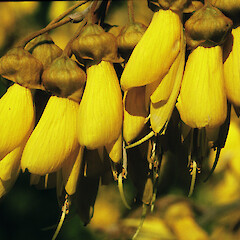Sophora tetraptera
Common name
kōwhai, large-leaved kōwhai
Synonyms
Edwardsia grandiflora (J.S.Mill.) Salisb., Edwardsia tetraptera (J.Mill.) W.R.B.Oliv.
Family
Fabaceae
Flora category
Vascular – Native
Endemic taxon
Yes
Endemic genus
No
Endemic family
No
Structural class
Trees & Shrubs - Dicotyledons
NVS code
The National Vegetation Survey (NVS) Databank is a physical archive and electronic databank containing records of over 94,000 vegetation survey plots - including data from over 19,000 permanent plots. NVS maintains a standard set of species code abbreviations that correspond to standard scientific plant names from the Ngä Tipu o Aotearoa - New Zealand Plants database.
SOPTET
Chromosome number
2n = 18
Current conservation status
The conservation status of all known New Zealand vascular plant taxa at the rank of species and below were reassessed in 2017 using the New Zealand Threat Classification System (NZTCS) – more information about this can be found on the NZTCS website. This report includes a statistical summary and brief notes on changes since 2012 and replaces all previous NZTCS lists for vascular plants.
Please note, threat classifications are often suggested by authors when publications fall between NZTCS assessment periods – an interim threat classification status has not been assessed by the NZTCS panel.
- Conservation status of New Zealand indigenous vascular plants, 2017 . 2018. Peter J. de Lange, Jeremy R. Rolfe, John W. Barkla, Shannel P. Courtney, Paul D. Champion, Leon R. Perrie, Sarah M. Beadel, Kerry A. Ford, Ilse Breitwieser, Ines Schönberger, Rowan Hindmarsh-Walls, Peter B. Heenan and Kate Ladley. Department of Conservation. Source: NZTCS and licensed by DOC for reuse under the Creative Commons Attribution 4.0 International licence.
2017 | Not Threatened
Previous conservation statuses
2012 | Not Threatened
2009 | Not Threatened
2004 | Not Threatened
Brief description
A commonly-grown kowhai tree bearing leaves 100-220 long that have widely-spaced greyish-green leaflets 15-40mm long and with bunches of drooping yellow flowers and dry ridged and knobbly seed pods 100-280mm long containing hard yellow seeds. Juveniles and adults similar. Naturally occurring in the eastern North Island, Taupo and Waikato River.
Distribution
Endemic. Known in a natural state only from the eastern portion of the the North Island from East Cape south to the Wairarapa, extending west toward Taihape, Lake Taupo and along the Waikato River to about Lake Karapiro. However, extensively planted outside this range and often naturalising.
Habitat
Widespread and common from coastal forested habitats inland along rivers and within associated low scrub and forest. Common around lake margins (especially Lake Taupo) and on ignimbrite cliffs bordering the upper Waikato River. Although a primarily lowland species it can occur in montane riparian forest.
Detailed description
Tree up to 15 m tall, trunk 0.6-1 m diam., often several arising from ground. Branches spreading, sometimes pendulous. Branchlets clad in golden yellow or grey tomentum. Juvenile plants not divaricating or flexuous, exhibiting an erect growth, non-interlacing habit from germination. Leaves 100-150(-220) mm, imparipinnate, moderately hairy, hairs, straight, appressed. Leaflets 10-20(-25) pairs, 15-35(-40) x 5-8 mm, well spaced, never overlapping or crowded, narrowly ovate to elliptic-oblong. Inflorescences racemose with up to 10 flowers. Calyx 10-20 x 10-15 mm, cupulate. Flowers golden-yellow, keel petal blade 20-50(-60) x 10-16(-18) mm, wing petal blade 25-50(-62) x 10-16 mm, standard petal blade 30-35(-42) x 18-30(-35) mm; petals with distinct claws 6-8 mm long. Fruit (100-)200(-280) mm long, broadly 4-winged, brown, with 6-12 or more seeds. Seeds 6.5-9(-10) x 6-7.5 mm, oblong, elliptic to orbicular, yellow to light yellow-brown.
Similar taxa
Easily distinguished from all other Kowhai species by the very large and wide grey-green leaves, with the leaflets 15-35 mm x 5-8 mm, ovate to elliptic -oblong, densely clad in silky, straight, appressed hairs. From the members of the S. microphylla complex it can also be distinguished by the flowers whose standard is distinctly less than the length of the wings.
Flowering
(September-) October-December
Flower colours
Yellow
Fruiting
October-May
Propagation technique
Easy from seed, provided the hard seed shell is nicked first with a knife or rubbed with sandpaper to expose the endosperm. Soaking seed treated this way overnight often helps speed up germination. Can be grown with difficulty from cuttings.
Threats
The main threat that faces all wild New Zealand kowhai species is the risk posed through planting for revegetation and horticultural purposes of hybrid material, foreign species, such as the Chilean Pelu (S. cassioides) and also of kowhai species outside their natural range. However, S. tetraptera seems to be very common throughout its range, and is adequately protected within a range of reserves and land set aside for conservation purposes.
Etymology
sophora: After the Arabic name for a similar tree
tetraptera: Four winged
Where To Buy
Commonly available at most commercial nurseries. A popular native tree for larger gardens. Some plants sold by nurseries are possibly hybrids with S. microphylla.
Poisonous plant
All parts of the plant but especially the ripe yellow seed are poisonous. Because the seed are hard they will take a lot of chewing to cause harm, and also will need to be consumed in large quantities to effectively poison a human. If the seed are crushed before eating it is more likely that they will cause harm. The major toxin is Cytisine and symptoms of poisoning include nausea, vomiting, increased heart rate, twitching of muscles or loss of coordination. Onset of these symptoms may occur within one hour. In extreme cases symptoms include paralysis and respiratory failure. Click on this link for more information about Poisonous native plants.
Attribution
Fact Sheet prepared for NZPCN by P.J. de Lange (31 July 2004). Description adapted from Allan (1961).
References and further reading
Allan, H.H. 1961: Flora of New Zealand. Vol. I. Wellington, Government Printer.
Anonymous. 1944. Kowhai. Wellington Botanical Society Bulletin 9: 4-5
NZPCN Fact Sheet citation
Please cite as: de Lange, P.J. (Year at time of access): Sophora tetraptera Fact Sheet (content continuously updated). New Zealand Plant Conservation Network. https://www.nzpcn.org.nz/flora/species/sophora-tetraptera/ (Date website was queried)














